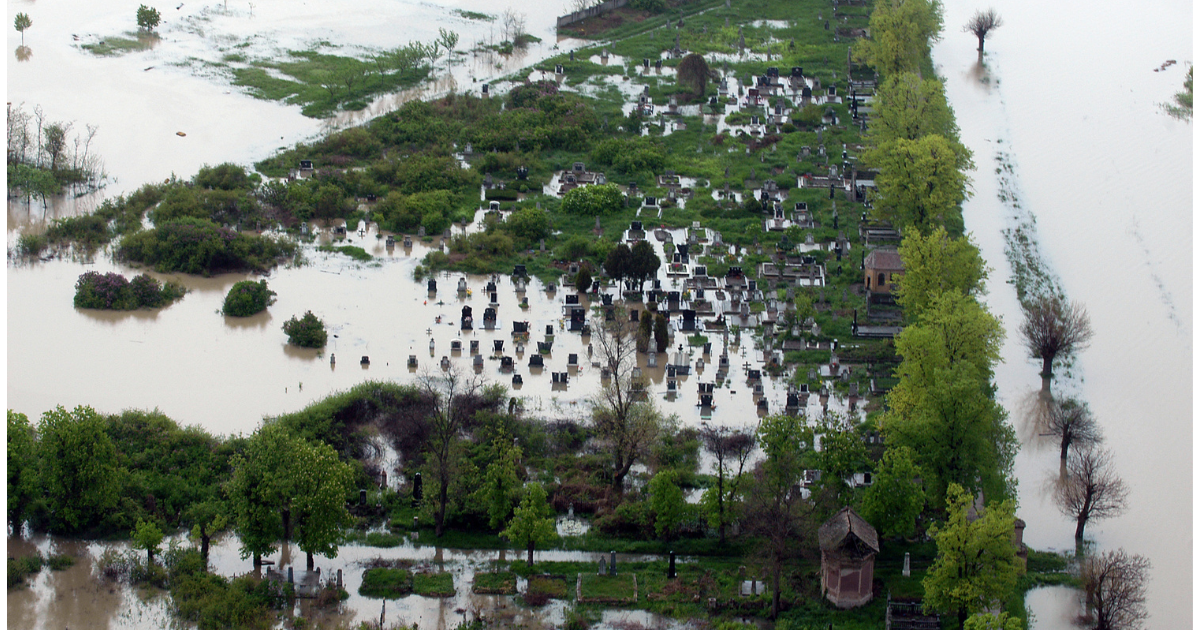Dealing with Cemetery Disinterment and Displacement after a Natural Disaster
In the weeks since Hurricane Helene dumped a deluge of rain on the already-saturated Southeast, thousands of heartbreaking videos of the aftermath have hit YouTube. One of these videos, which focused on search and rescue/recovery efforts in Avery County, North Carolina, illustrated a problem that often accompanies disastrous flooding: Casket displacement, retrieval, and identification.
In that video, which was posted on October 8, a reporter from Queen City News of Charlotte traveled along with deputies from a search and rescue team along the Elk River as they looked for a casket that drone footage had picked up days earlier.
“That’s somebody’s loved one out there that we need to bring home,” one deputy said. “They’re not garbage. We don’t need to leave them out on the riverbank. We need to bring everyone home.”
Deputies couldn’t get to the casket because the area’s roads had been obliterated by Helene. The National Guard was brought in to hike the miles of terrain in search of the casket, which was coffin-shaped and appeared to be quite old. The reporter ended the video saying that the Guard members’ efforts were unsuccessful that day, but they’d be back to continue the search.
A common problem
Videos showing caskets racing down a raging river or images of caskets and gaping vaults poking awkwardly out of graves aren’t at all uncommon after natural disasters that dump torrential amounts of rain on a community. But it’s not just flooding that can displace a gravesite; mudslides, high water tables, and storm surges can also wreak havoc.
The following incidents of unearthed caskets — and the problems that accompany them — were reported just within the last 10 months:
- Family heartbroken after casket unearthed from Charleston cemetery during flood
- Relatives want change at Monrovia Cemetery, where flooding unearthed caskets. Again.
- Floodwaters expose several caskets in Lowcountry cemeteries
- Unearthed: Dozens of remains still unidentified nearly three years after Hurricane Ida damaged cemeteries
Hurricane Ida, mentioned in the last item above, unearthed 282 caskets when it pummeled southeast Louisiana in 2021. More than 1,500 gravesites were destroyed, displaced, or dislocated by Hurricane Katrina in 2005. And the totals from Hurricane Helene could take months or longer to tally.
Many believe the problem is only going to get worse as the ecological effects of climate change escalate. In addition to water-related tragedies, climate change is sparking wildfires that obliterate gravestones, turning cemeteries into swamps as permafrost melts in Alaska, and storm surges and rising sea leaves are steadily eroding coastal land, including cemeteries where the long-dead rest.
Why it happens
The science behind the disinterment-by-water phenomenon is pretty basic. Modern airtight caskets and vaults simply build up pressure when surrounded by water. Sealed vault tops pop open, and caskets become so buoyant that they float up and out of the grave. Once displaced, the incredible force of rushing water (weighing about 1,700 pounds per cubic yard, one foot of flood water can displace 1,500 pounds) can send caskets, vaults, and remains on a journey that lands them miles away from their original location.
Cities in low-lying areas (like New Orleans, for example) mitigate potential disinterment by burying their dead above-ground. This doesn’t prevent displacement, though, as Hurricane Katrina proved in 2005. In the end, Mother Nature can always find a way to conquer cemeteries.
The conundrum of recovery
The aforementioned situation in Avery County, North Carolina brings up a polarizing issue: how should authorities prioritize recovery efforts for the long-dead when so many of the recently presumed dead are still missing? There’s truly no right or good answer.
However and whenever a casket is recovered, though, there are certain protocols that are followed to try to identify and hopefully re-inter the deceased. Many can be identified by the casket’s serial number or the scrolls in the casket’s memory tube. If that’s not an option, the casket’s contents will be searched for items deposited with the body or personalized details like embroidered pillows or lid panels. Jewelry and clothing can also help with identification. If those efforts aren’t successful, DNA, dental records, or serial numbers on replacement body parts are usually last-ditch options. Often these duties are performed by the government’s DMORT teams, which are made up of deathcare professionals and other specialists.
After identification, families, cemetery workers, volunteer organizations, and government units work together to rebury the remains. In 2016, Louisiana formed a Cemetery Response Task Force to coordinate the multifaceted work of restoring cemeteries and their inhabitants to their original state after a natural disaster. After Hurricanes Laura and Delta, the task force solicited “Good Samaritan” volunteers and encouraged families and cemetery owners/managers to apply for an $8,000-per-grave award from the Federal Emergency Management Agency (FEMA) for cemetery repairs.
Sadly, some of the deceased are never located, while some of those that are located are never identified. Three years after 2021’s Hurricane Ida, Louisiana’s task force is still working to identify 40 bodies in the Ironton area; the remains are temporarily stored in two semi trailers as families patiently waited for word on their loved ones.
Mitigation and preparation
For inactive or abandoned cemeteries, little can be done to prepare for natural disasters or mitigate potential disinterment or displacement. Some families have covered graves with sandbags ahead of a storm or created heavy-duty bolted-together concrete contraptions as a long-term solution.
However, most emergency response authorities encourage active cemeteries to create mitigation plans to better prepare for the possibility of a catastrophe. In 2016, the Natural Hazards Center published Preserving the Dead: Cemetery Preservation and Disaster Planning, a document that detailed the potential impact to cemeteries from weather-related tragedies and offered recommendations on how to prepare. These steps included evaluating high-risk topography like low-lying flood-prone areas, ensuring cemetery records are complete and secure, and the entire property is thoroughly and accurately surveyed and mapped. The document also recommends maintaining proper insurance coverage and remaining aware of government resources.
While no one can always predict how or when a natural disaster will impact a cemetery, families will appreciate the fact that the property is prepared for recovery when and if it becomes necessary.




